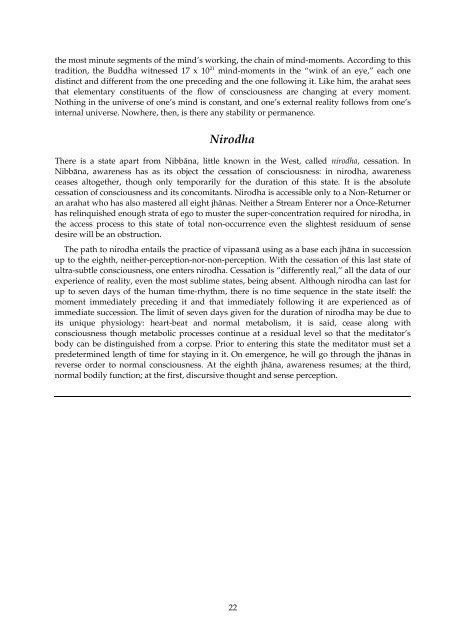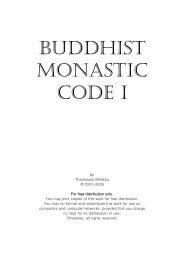THE BUDDHA W MEDITATION - Theravada Buddhism
THE BUDDHA W MEDITATION - Theravada Buddhism
THE BUDDHA W MEDITATION - Theravada Buddhism
You also want an ePaper? Increase the reach of your titles
YUMPU automatically turns print PDFs into web optimized ePapers that Google loves.
the most minute segments of the mind’s working, the chain of mind-moments. According to this<br />
tradition, the Buddha witnessed 17 x 10 21 mind-moments in the “wink of an eye,” each one<br />
distinct and different from the one preceding and the one following it. Like him, the arahat sees<br />
that elementary constituents of the flow of consciousness are changing at every moment.<br />
Nothing in the universe of one’s mind is constant, and one’s external reality follows from one’s<br />
internal universe. Nowhere, then, is there any stability or permanence.<br />
Nirodha<br />
There is a state apart from Nibbāna, little known in the West, called nirodha, cessation. In<br />
Nibbāna, awareness has as its object the cessation of consciousness: in nirodha, awareness<br />
ceases altogether, though only temporarily for the duration of this state. It is the absolute<br />
cessation of consciousness and its concomitants. Nirodha is accessible only to a Non-Returner or<br />
an arahat who has also mastered all eight jhānas. Neither a Stream Enterer nor a Once-Returner<br />
has relinquished enough strata of ego to muster the super-concentration required for nirodha, in<br />
the access process to this state of total non-occurrence even the slightest residuum of sense<br />
desire will be an obstruction.<br />
The path to nirodha entails the practice of vipassanā using as a base each jhāna in succession<br />
up to the eighth, neither-perception-nor-non-perception. With the cessation of this last state of<br />
ultra-subtle consciousness, one enters nirodha. Cessation is “differently real,” all the data of our<br />
experience of reality, even the most sublime states, being absent. Although nirodha can last for<br />
up to seven days of the human time-rhythm, there is no time sequence in the state itself: the<br />
moment immediately preceding it and that immediately following it are experienced as of<br />
immediate succession. The limit of seven days given for the duration of nirodha may be due to<br />
its unique physiology: heart-beat and normal metabolism, it is said, cease along with<br />
consciousness though metabolic processes continue at a residual level so that the meditator’s<br />
body can be distinguished from a corpse. Prior to entering this state the meditator must set a<br />
predetermined length of time for staying in it. On emergence, he will go through the jhānas in<br />
reverse order to normal consciousness. At the eighth jhāna, awareness resumes; at the third,<br />
normal bodily function; at the first, discursive thought and sense perception.<br />
22






